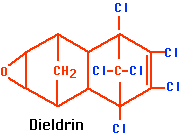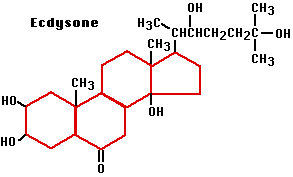| Index to this page |
Inorganic compounds of arsenic, such as lead arsenate, have long been used against insect pests.
However, these materialsPyrethrins break down so rapidly in sunlight that they are of little use outdoors on crops. However, a number of synthetic pyrethrin-like substances — called pyrethroids — do not have this defect and are effective.
Example:| Link to a separate page on B. thuringiensis. |

DDT was the first of a long line of insecticides based on hydrocarbons with chlorine atoms replacing some of the hydrogen atoms. Its chemical name is dichloro, diphenyl, trichloroethane (see figure).
Some others:
DDT was introduced during World War II and, along with penicillin and the sulfa drugs, was responsible for the fact that this was the first war in history where trauma killed more people — combatants and noncombatants alike — than infectious disease.
DDT is effective againstPrior to the introduction of DDT, the number of cases of malaria in Ceylon (now Sri Lanka) was more than a million a year. By 1963 the disease had been practically eliminated from the island. However, growing concern about the drawbacks of DDT led to its abandonment there in the mid-1960s, and soon thereafter malaria became common once again reaching more than 500,000 cases a year by 1969. (Happily, another multi-pronged campaign has once again eliminated the disease with no new cases seen since 2013.)
DDT was especially effective against malarial mosquitoes because of its persistence — its resistance to breakdown in the environment. One or two sprays a year on the walls of homes kept them free of mosquitoes.
But DDT has several serious drawbacks.These properties cause it to accumulate in fat tissue. People who were heavily exposed to DDT (during its manufacture or application) often showed concentrations of DDT in their fat 1000 times higher than that in their blood.
Even these high levels were probably of little harm to the workers. In the early stages of exposure, the blood levels of DDT (and its metabolite DDE) rise rapidly at first and then reach a steady level. From that point on, the body excretes it as fast as it acquires it.
Although no harmful effects from average exposures to DDT have been seen in humans, DDT and other chlorinated hydrocarbons have been shown to harm other species, such as fishes, earthworms, and robins.
The hazard of DDT to nontarget animals is particularly acute for those species living at the top of food chains.| Link to discussion of how DDT becomes concentrated as it moves up a food chain. |
Carnivores at the ends of long food chains (e.g., ospreys, pelicans, falcons, and eagles) once suffered serious declines in fecundity and hence in population size because of this. High levels of chlorinated hydrocarbons interfere with forming eggshells of normal thickness.
| Correlation between DDE concentrations in the eggs of Alaskan falcons and hawks and reduction in the thickness of their eggshells (compared with shells collected prior to 1947). DDE is a metabolite of DDT. Data from T. J. Cade, et. al., Science 172:955, 1971. | |||
| Species | Location | Average Concentration of DDE in Eggs (ppm) |
Reduction in Shell Thickness |
|---|---|---|---|
| Peregrine falcon | Alaskan tundra (north slope) | 889 | -21.7% |
| Peregrine falcon | Central Alaska | 673 | -16.8% |
| Peregrine falcon | Aleutian Islands | 167 | -7.5% |
| Rough-legged hawk | Alaskan tundra (north slope) | 22.5 | -3.3% |
| Gyrfalcon | Seward Peninsular, Alaska | 3.88 | 0 |
Another group of nontarget victims of DDT (and other pesticides) are insects that prey upon insect pests; that is, the natural enemies of the pests. Killing these has serious ecological — and economic! — effects. For example, once apple growers began controlling pests with DDT, they quickly found their orchards being attacked by scale insects and mites. The reason: DDT had killed off their natural enemies.

The organophosphates, e.g., parathion (right), are related to the nerve gases developed during World War II.
They react irreversibly with the enzyme acetylcholinesterase, which is responsible for inactivating acetylcholine (ACh) at neuromuscular junctions and at certain synapses in the central and peripheral nervous systems.
Some other examples:
Some of the organophosphates are very toxic. Parathion, for example, is 30 times more toxic than DDT. Each year organophosphates poison thousands of humans throughout the world, causing hundreds of deaths. Medical personnel caring for poisoning victims are also at risk. They may be seriously poisoned by the excretions of, and even the vapors emanating from, their patients.
This table gives the LD50 values [Discussion] for some insecticides. In each case, the chemical was fed to laboratory rats. Note that the lower the LD50, the more toxic the chemical.
| Chemical | Category | Oral LD50 in Rats (mg/kg) |
|---|---|---|
| Aldicarb ("Temik") | Carbamate | 1 |
| Carbaryl ("Sevin") | Carbamate | 307 |
| DDT | Chlorinated hydrocarbon | 87 |
| Dieldrin | Chlorinated hydrocarbon | 40 |
| Diflubenzuron ("Dimilin") | Chitin inhibitor | 10,000 |
| Malathion | Organophosphate | 885 |
| Methoprene | JH mimic | 34,600 |
| Methoxychlor | Chlorinated hydrocarbon | 5,000 |
| Parathion | Organophosphate | 3 |
| Piperonyl butoxide | Synergist | 7,500 |
| Pyrethrins | Plant extract | 200 |
| Rotenone | Plant extract | 60 |
Unlike chlorinated hydrocarbons,
Development of resistance is just as much a problem as it is with the chlorinated hydrocarbons. The carbamates were introduced in an attempt to keep ahead.

Some examples:
Features:
The members of this diverse group interfere — in one way or another — with insect development.
Although most insect growth regulators do not affect adults, for many pests, it is the larval stages that are the most destructive.

Insects must periodically shed their exoskeleton — called molting — in order to grow. Each molt is triggered by a steroid hormone called ecdysone.
| Link to discussion of the hormones involved in insect development. |
A few synthetic ecdysone
In some insects, the final molt produces an adult that looks pretty much like the earlier larval stages. In others, like moths and butterflies, the final molt of the larva (caterpillar) produces a pupa. After a period of metamorphosis, the adult moth emerges.
Ecdysone triggers larva-to-larva molts as long as another hormone, called juvenile hormone (JH), is present. In its absence, ecdysone promotes the pupa-to-adult molt. Thus normal metamorphosis seems to occur when the output of JH diminishes spontaneously in the mature caterpillar.

When solutions of JH are sprayed on mature caterpillars, or on the foliage upon which they are feeding, their normal development is upset. This raises the possibility of using JH as an insecticide (one that might avoid the problem of developing resistance).
As it turns out, JH is too unstable to be practical, but some synthetic JH mimics, e.g.,These are substances, first discovered in plants, that damage the corpora allata thus preventing juvenile hormone (JH) from doing its normal job. Applied to early larval stages, precocenes induce premature or precocious metamorphosis (like that induced by the surgical removal of the corpora allata [View]).
Not only does precocious metamorphosis cut short the destructive larval phase of the insect, but the adults are abnormal (besides being small). The females, for example, are sterile (because JH is needed for development of the ovaries).
It is often said that the evolution of insecticide resistance requires the introduction of ever more powerful insecticides. But what is really needed is a new substance that attacks some other chink in the insect's armor. Whether gram for gram the new substance is more or less toxic to the insect (and whether its LD50 for mammals is lower or higher) is quite a separate issue.
| Welcome&Next Search |